Analyzing Organizational Culture and Performance in Apple Inc.
VerifiedAdded on 2020/04/01
|24
|6942
|167
AI Summary
The assignment examines how Apple Inc.'s organizational culture impacts its business success. It delves into key elements such as leadership style, communication practices, and the company’s approach to innovation and ethical standards. By evaluating these factors, students will gain insights into the relationship between a robust organizational culture and enhanced firm performance, with specific references to existing literature on corporate social responsibility and management effectiveness.
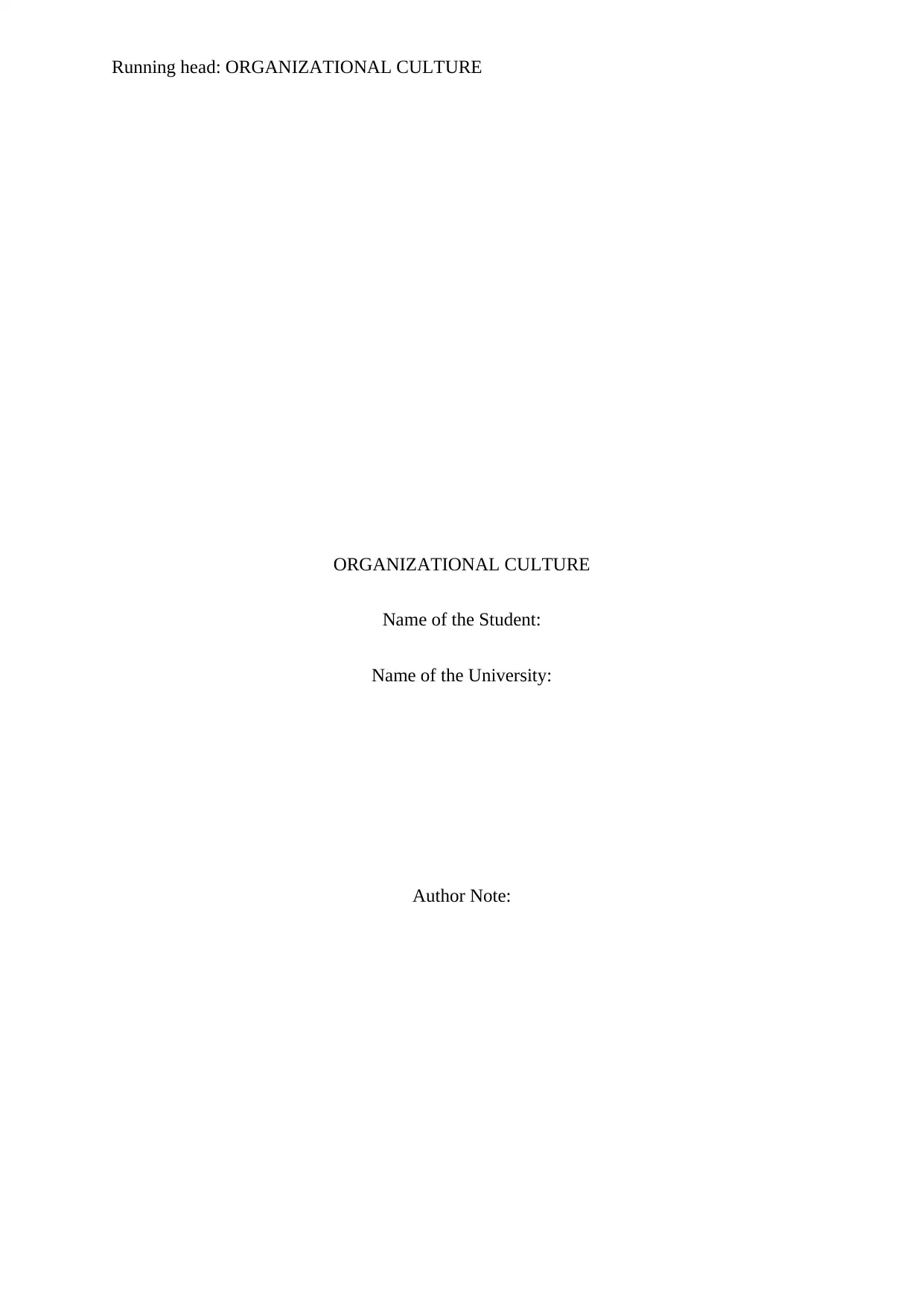
Running head: ORGANIZATIONAL CULTURE
ORGANIZATIONAL CULTURE
Name of the Student:
Name of the University:
Author Note:
ORGANIZATIONAL CULTURE
Name of the Student:
Name of the University:
Author Note:
Paraphrase This Document
Need a fresh take? Get an instant paraphrase of this document with our AI Paraphraser

1ORGANIZATIONAL CULTURE
Executive Summary
Organizational culture is one of the most important things in today’s world that
determines the success of the organizations. Organizational culture is characterized by taking
all the past experiences of the organization, its expectations, the philosophical beliefs and
values and making the guidelines about how would the organization itself or, through its
employees interact with the outer world. The organizational culture is expressed through the
organization’s own imagery of itself and its internal functions. Organizational culture also,
often, decide the future expectations of the company: what is the desired profit rate or what
are the primary and secondary goals or the projected growth rate.
The following report would look in the matter at more detail and try to understand
what makes it such an important aspect of running a business and what are the characteristic
and traits of organizational culture. It would also look into the basic principles which outline
how organizational culture is built for particular organizations and why is it unique for every
organization.
The following sections will take three different case studies and look into three
different organizational culture aspects which have been emphasized by the three
organizations and try to establish the fact that different approaches to organizational culture
do, in fact, help a company to become successful and dominate the market.
Executive Summary
Organizational culture is one of the most important things in today’s world that
determines the success of the organizations. Organizational culture is characterized by taking
all the past experiences of the organization, its expectations, the philosophical beliefs and
values and making the guidelines about how would the organization itself or, through its
employees interact with the outer world. The organizational culture is expressed through the
organization’s own imagery of itself and its internal functions. Organizational culture also,
often, decide the future expectations of the company: what is the desired profit rate or what
are the primary and secondary goals or the projected growth rate.
The following report would look in the matter at more detail and try to understand
what makes it such an important aspect of running a business and what are the characteristic
and traits of organizational culture. It would also look into the basic principles which outline
how organizational culture is built for particular organizations and why is it unique for every
organization.
The following sections will take three different case studies and look into three
different organizational culture aspects which have been emphasized by the three
organizations and try to establish the fact that different approaches to organizational culture
do, in fact, help a company to become successful and dominate the market.
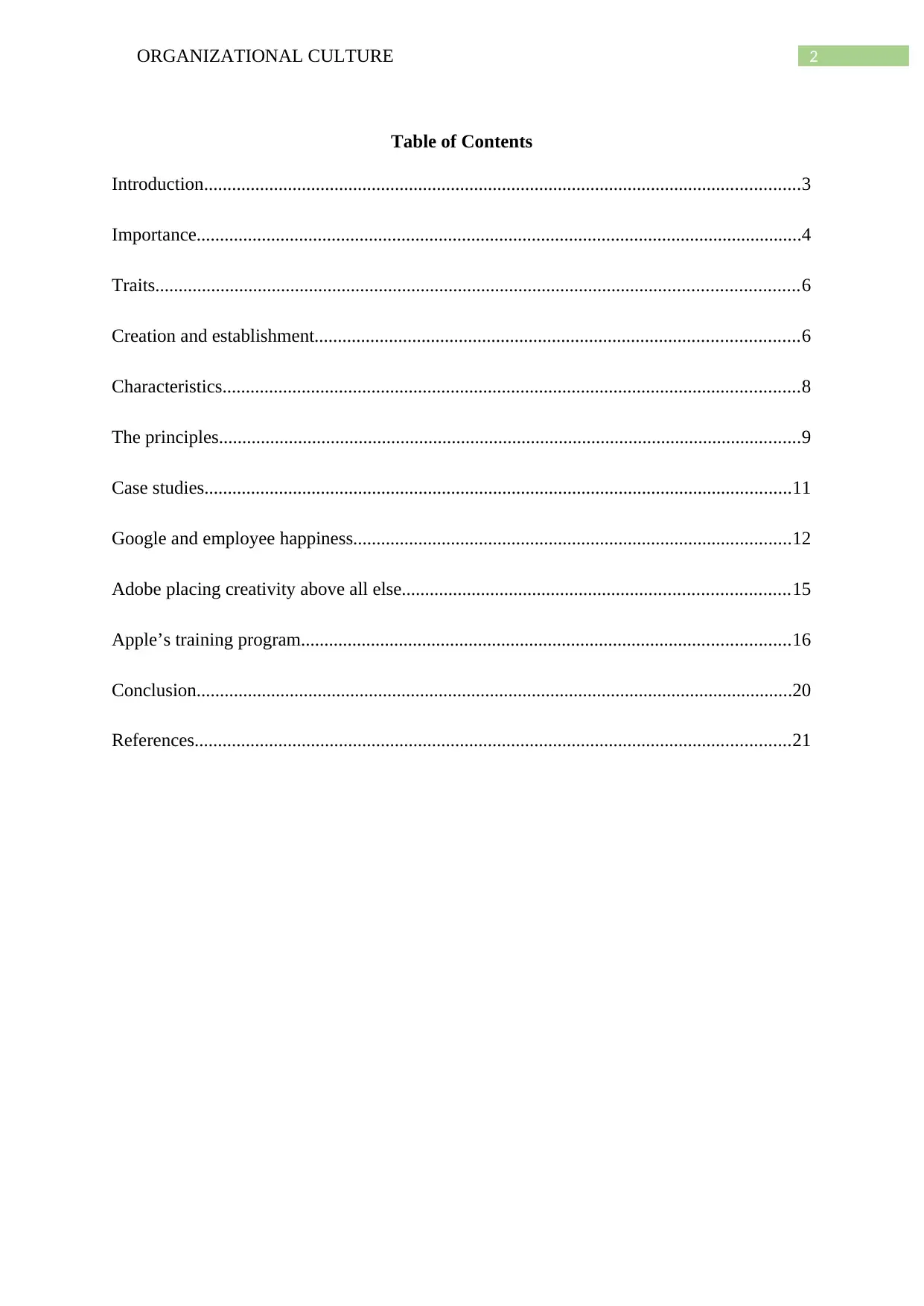
2ORGANIZATIONAL CULTURE
Table of Contents
Introduction................................................................................................................................3
Importance..................................................................................................................................4
Traits..........................................................................................................................................6
Creation and establishment........................................................................................................6
Characteristics............................................................................................................................8
The principles.............................................................................................................................9
Case studies..............................................................................................................................11
Google and employee happiness..............................................................................................12
Adobe placing creativity above all else...................................................................................15
Apple’s training program.........................................................................................................16
Conclusion................................................................................................................................20
References................................................................................................................................21
Table of Contents
Introduction................................................................................................................................3
Importance..................................................................................................................................4
Traits..........................................................................................................................................6
Creation and establishment........................................................................................................6
Characteristics............................................................................................................................8
The principles.............................................................................................................................9
Case studies..............................................................................................................................11
Google and employee happiness..............................................................................................12
Adobe placing creativity above all else...................................................................................15
Apple’s training program.........................................................................................................16
Conclusion................................................................................................................................20
References................................................................................................................................21
⊘ This is a preview!⊘
Do you want full access?
Subscribe today to unlock all pages.

Trusted by 1+ million students worldwide
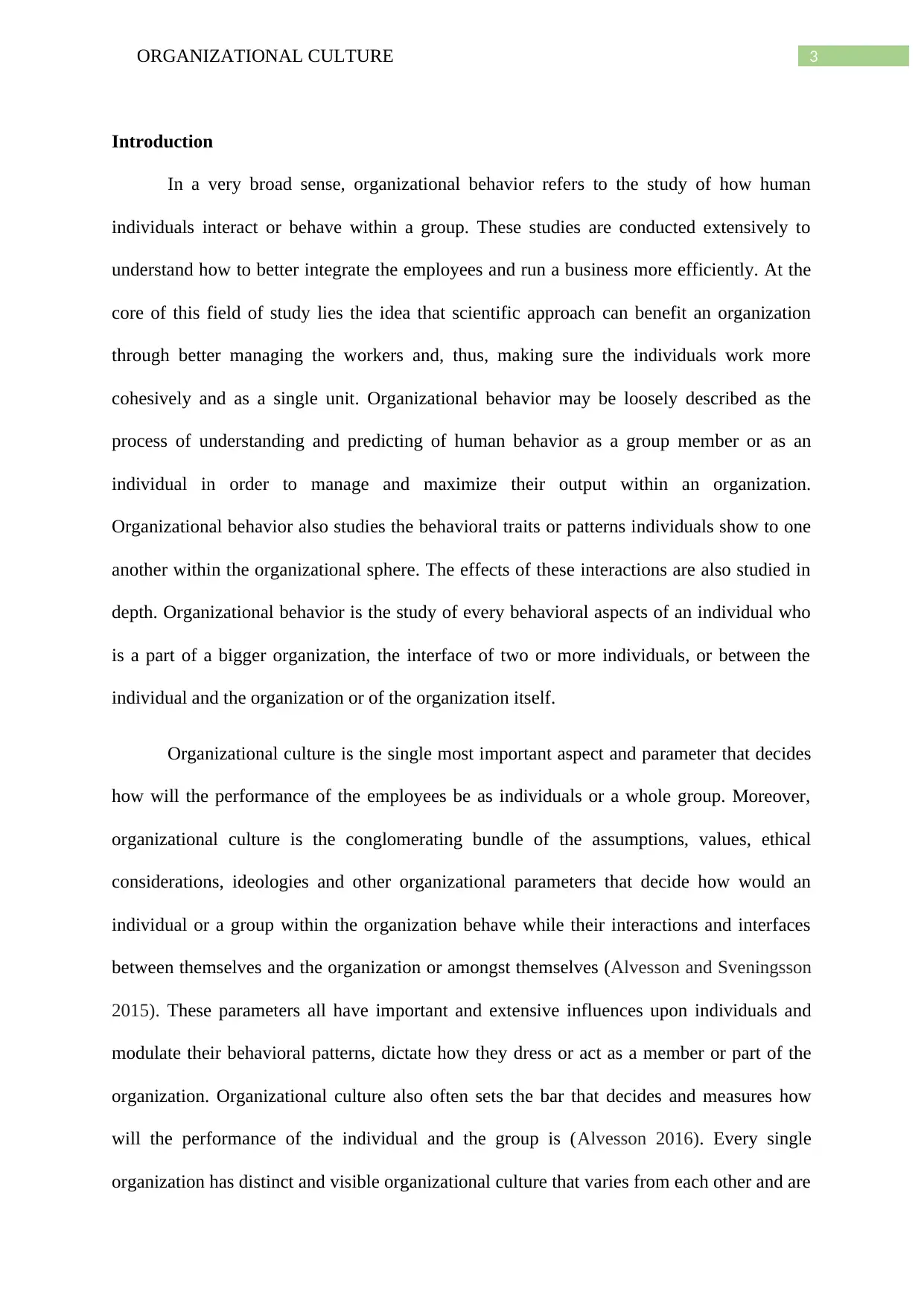
3ORGANIZATIONAL CULTURE
Introduction
In a very broad sense, organizational behavior refers to the study of how human
individuals interact or behave within a group. These studies are conducted extensively to
understand how to better integrate the employees and run a business more efficiently. At the
core of this field of study lies the idea that scientific approach can benefit an organization
through better managing the workers and, thus, making sure the individuals work more
cohesively and as a single unit. Organizational behavior may be loosely described as the
process of understanding and predicting of human behavior as a group member or as an
individual in order to manage and maximize their output within an organization.
Organizational behavior also studies the behavioral traits or patterns individuals show to one
another within the organizational sphere. The effects of these interactions are also studied in
depth. Organizational behavior is the study of every behavioral aspects of an individual who
is a part of a bigger organization, the interface of two or more individuals, or between the
individual and the organization or of the organization itself.
Organizational culture is the single most important aspect and parameter that decides
how will the performance of the employees be as individuals or a whole group. Moreover,
organizational culture is the conglomerating bundle of the assumptions, values, ethical
considerations, ideologies and other organizational parameters that decide how would an
individual or a group within the organization behave while their interactions and interfaces
between themselves and the organization or amongst themselves (Alvesson and Sveningsson
2015). These parameters all have important and extensive influences upon individuals and
modulate their behavioral patterns, dictate how they dress or act as a member or part of the
organization. Organizational culture also often sets the bar that decides and measures how
will the performance of the individual and the group is (Alvesson 2016). Every single
organization has distinct and visible organizational culture that varies from each other and are
Introduction
In a very broad sense, organizational behavior refers to the study of how human
individuals interact or behave within a group. These studies are conducted extensively to
understand how to better integrate the employees and run a business more efficiently. At the
core of this field of study lies the idea that scientific approach can benefit an organization
through better managing the workers and, thus, making sure the individuals work more
cohesively and as a single unit. Organizational behavior may be loosely described as the
process of understanding and predicting of human behavior as a group member or as an
individual in order to manage and maximize their output within an organization.
Organizational behavior also studies the behavioral traits or patterns individuals show to one
another within the organizational sphere. The effects of these interactions are also studied in
depth. Organizational behavior is the study of every behavioral aspects of an individual who
is a part of a bigger organization, the interface of two or more individuals, or between the
individual and the organization or of the organization itself.
Organizational culture is the single most important aspect and parameter that decides
how will the performance of the employees be as individuals or a whole group. Moreover,
organizational culture is the conglomerating bundle of the assumptions, values, ethical
considerations, ideologies and other organizational parameters that decide how would an
individual or a group within the organization behave while their interactions and interfaces
between themselves and the organization or amongst themselves (Alvesson and Sveningsson
2015). These parameters all have important and extensive influences upon individuals and
modulate their behavioral patterns, dictate how they dress or act as a member or part of the
organization. Organizational culture also often sets the bar that decides and measures how
will the performance of the individual and the group is (Alvesson 2016). Every single
organization has distinct and visible organizational culture that varies from each other and are
Paraphrase This Document
Need a fresh take? Get an instant paraphrase of this document with our AI Paraphraser
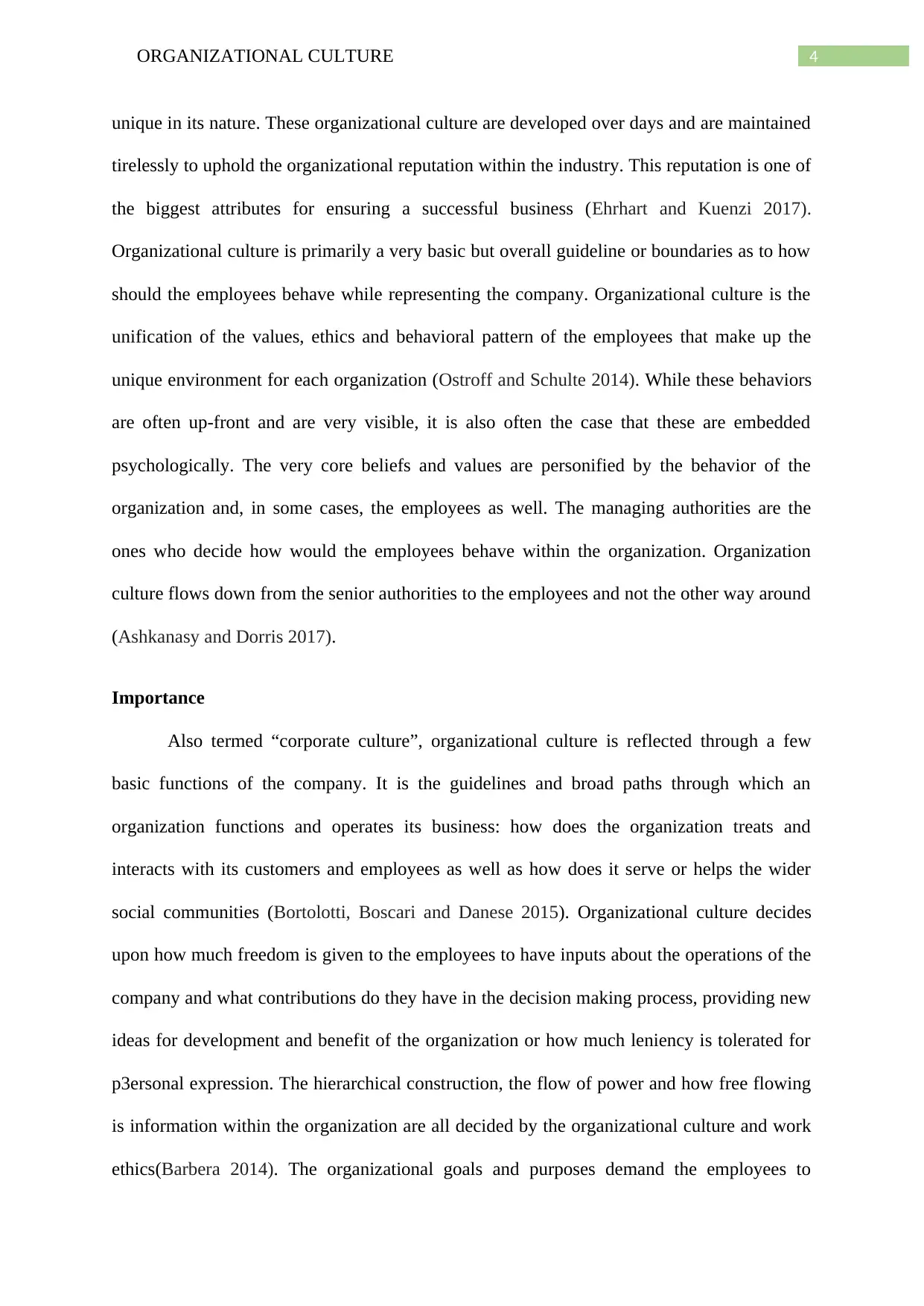
4ORGANIZATIONAL CULTURE
unique in its nature. These organizational culture are developed over days and are maintained
tirelessly to uphold the organizational reputation within the industry. This reputation is one of
the biggest attributes for ensuring a successful business (Ehrhart and Kuenzi 2017).
Organizational culture is primarily a very basic but overall guideline or boundaries as to how
should the employees behave while representing the company. Organizational culture is the
unification of the values, ethics and behavioral pattern of the employees that make up the
unique environment for each organization (Ostroff and Schulte 2014). While these behaviors
are often up-front and are very visible, it is also often the case that these are embedded
psychologically. The very core beliefs and values are personified by the behavior of the
organization and, in some cases, the employees as well. The managing authorities are the
ones who decide how would the employees behave within the organization. Organization
culture flows down from the senior authorities to the employees and not the other way around
(Ashkanasy and Dorris 2017).
Importance
Also termed “corporate culture”, organizational culture is reflected through a few
basic functions of the company. It is the guidelines and broad paths through which an
organization functions and operates its business: how does the organization treats and
interacts with its customers and employees as well as how does it serve or helps the wider
social communities (Bortolotti, Boscari and Danese 2015). Organizational culture decides
upon how much freedom is given to the employees to have inputs about the operations of the
company and what contributions do they have in the decision making process, providing new
ideas for development and benefit of the organization or how much leniency is tolerated for
p3ersonal expression. The hierarchical construction, the flow of power and how free flowing
is information within the organization are all decided by the organizational culture and work
ethics(Barbera 2014). The organizational goals and purposes demand the employees to
unique in its nature. These organizational culture are developed over days and are maintained
tirelessly to uphold the organizational reputation within the industry. This reputation is one of
the biggest attributes for ensuring a successful business (Ehrhart and Kuenzi 2017).
Organizational culture is primarily a very basic but overall guideline or boundaries as to how
should the employees behave while representing the company. Organizational culture is the
unification of the values, ethics and behavioral pattern of the employees that make up the
unique environment for each organization (Ostroff and Schulte 2014). While these behaviors
are often up-front and are very visible, it is also often the case that these are embedded
psychologically. The very core beliefs and values are personified by the behavior of the
organization and, in some cases, the employees as well. The managing authorities are the
ones who decide how would the employees behave within the organization. Organization
culture flows down from the senior authorities to the employees and not the other way around
(Ashkanasy and Dorris 2017).
Importance
Also termed “corporate culture”, organizational culture is reflected through a few
basic functions of the company. It is the guidelines and broad paths through which an
organization functions and operates its business: how does the organization treats and
interacts with its customers and employees as well as how does it serve or helps the wider
social communities (Bortolotti, Boscari and Danese 2015). Organizational culture decides
upon how much freedom is given to the employees to have inputs about the operations of the
company and what contributions do they have in the decision making process, providing new
ideas for development and benefit of the organization or how much leniency is tolerated for
p3ersonal expression. The hierarchical construction, the flow of power and how free flowing
is information within the organization are all decided by the organizational culture and work
ethics(Barbera 2014). The organizational goals and purposes demand the employees to
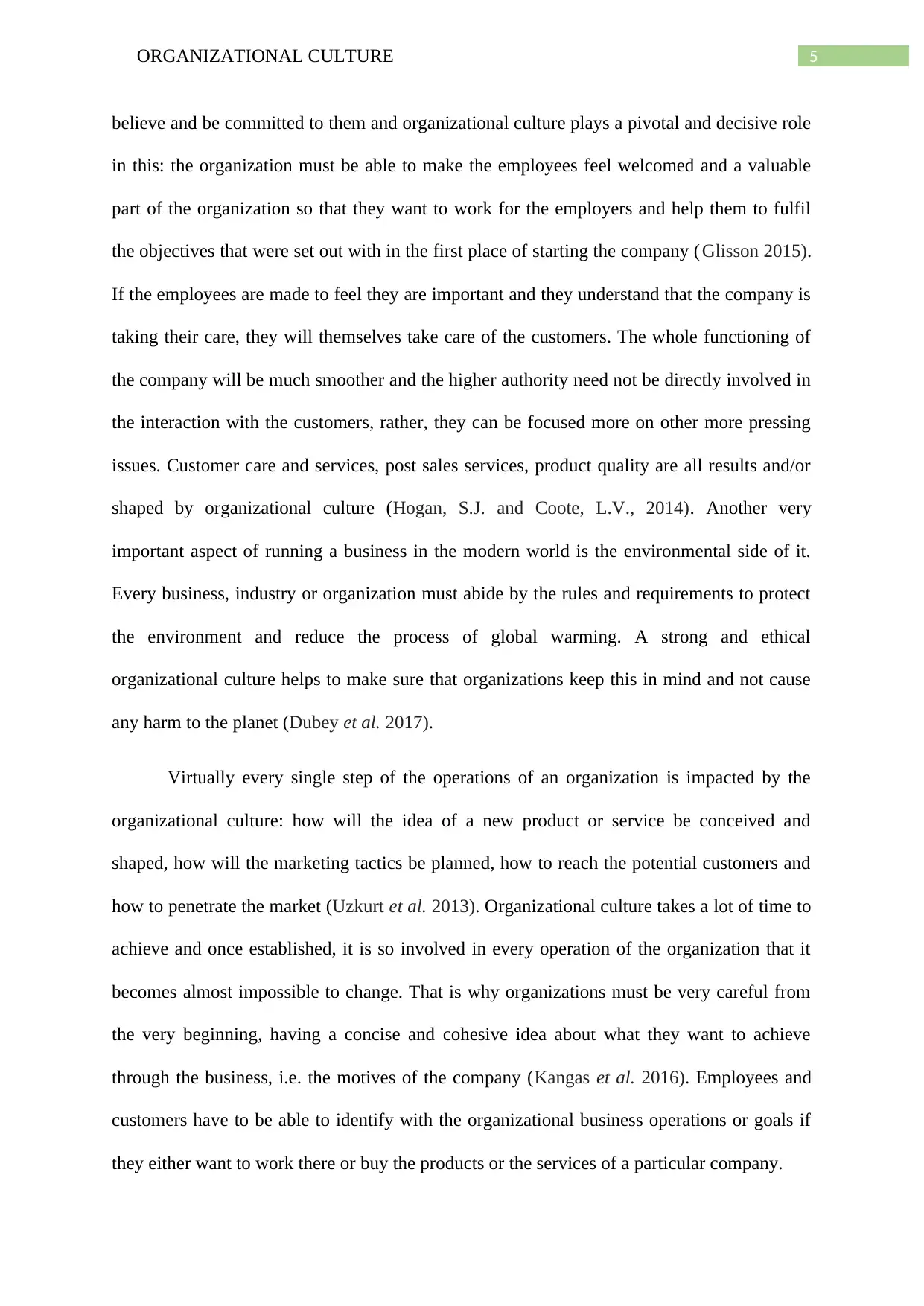
5ORGANIZATIONAL CULTURE
believe and be committed to them and organizational culture plays a pivotal and decisive role
in this: the organization must be able to make the employees feel welcomed and a valuable
part of the organization so that they want to work for the employers and help them to fulfil
the objectives that were set out with in the first place of starting the company ( Glisson 2015).
If the employees are made to feel they are important and they understand that the company is
taking their care, they will themselves take care of the customers. The whole functioning of
the company will be much smoother and the higher authority need not be directly involved in
the interaction with the customers, rather, they can be focused more on other more pressing
issues. Customer care and services, post sales services, product quality are all results and/or
shaped by organizational culture (Hogan, S.J. and Coote, L.V., 2014). Another very
important aspect of running a business in the modern world is the environmental side of it.
Every business, industry or organization must abide by the rules and requirements to protect
the environment and reduce the process of global warming. A strong and ethical
organizational culture helps to make sure that organizations keep this in mind and not cause
any harm to the planet (Dubey et al. 2017).
Virtually every single step of the operations of an organization is impacted by the
organizational culture: how will the idea of a new product or service be conceived and
shaped, how will the marketing tactics be planned, how to reach the potential customers and
how to penetrate the market (Uzkurt et al. 2013). Organizational culture takes a lot of time to
achieve and once established, it is so involved in every operation of the organization that it
becomes almost impossible to change. That is why organizations must be very careful from
the very beginning, having a concise and cohesive idea about what they want to achieve
through the business, i.e. the motives of the company (Kangas et al. 2016). Employees and
customers have to be able to identify with the organizational business operations or goals if
they either want to work there or buy the products or the services of a particular company.
believe and be committed to them and organizational culture plays a pivotal and decisive role
in this: the organization must be able to make the employees feel welcomed and a valuable
part of the organization so that they want to work for the employers and help them to fulfil
the objectives that were set out with in the first place of starting the company ( Glisson 2015).
If the employees are made to feel they are important and they understand that the company is
taking their care, they will themselves take care of the customers. The whole functioning of
the company will be much smoother and the higher authority need not be directly involved in
the interaction with the customers, rather, they can be focused more on other more pressing
issues. Customer care and services, post sales services, product quality are all results and/or
shaped by organizational culture (Hogan, S.J. and Coote, L.V., 2014). Another very
important aspect of running a business in the modern world is the environmental side of it.
Every business, industry or organization must abide by the rules and requirements to protect
the environment and reduce the process of global warming. A strong and ethical
organizational culture helps to make sure that organizations keep this in mind and not cause
any harm to the planet (Dubey et al. 2017).
Virtually every single step of the operations of an organization is impacted by the
organizational culture: how will the idea of a new product or service be conceived and
shaped, how will the marketing tactics be planned, how to reach the potential customers and
how to penetrate the market (Uzkurt et al. 2013). Organizational culture takes a lot of time to
achieve and once established, it is so involved in every operation of the organization that it
becomes almost impossible to change. That is why organizations must be very careful from
the very beginning, having a concise and cohesive idea about what they want to achieve
through the business, i.e. the motives of the company (Kangas et al. 2016). Employees and
customers have to be able to identify with the organizational business operations or goals if
they either want to work there or buy the products or the services of a particular company.
⊘ This is a preview!⊘
Do you want full access?
Subscribe today to unlock all pages.

Trusted by 1+ million students worldwide

6ORGANIZATIONAL CULTURE
Traits
Organizational culture is defined as an “emergence” of a state within an organization
that is highly complex and is incalculable. This state results from a few very simple
ingredients, though the final outcome is different for every organization. There are three
parameters within an organization that can be controlled, moderated and managed: the
employees, the work and the customers. These are the three basic pillars of any organization
and every single operation is executed and planned with focus on any, or all, three of these.
Organizational culture is almost always highly influenced by regional cultures (Modaff,
Butler and DeWine 2016). The beliefs and ideals of different social community shape how an
organization will behave, treat its customers and employees. These beliefs and values are
deep inside the collective social mentality, and it is only natural that these will be some of the
primary things to decide what will be the operations of the organization.
Creation and establishment
The creation of any organizational culture is dependent upon the beliefs and values of
its leaders. Workplace culture is entirely created by the leaders as they are the ones with a
proper idea about what is to be done band the true motives of the organization (Asgary and Li
2016). However, it is not the final deciding factor: while most of the times leaders do shape
the organizational culture, there are also times when organizational culture also decides what
kind of a leadership is possible, or how will the leaders behave him/herself. An established
culture influences and shapes a leader just as much as it being influenced by the leader
(Fullan 2014). An effective organizational culture decides and governs the mentality and
behavior of the employees and the authority that will ensure the employees reaching their
goals while adhering to the collective motivations. When an employee feels that she or he is
being assisted and helped by the leader to fulfil their personal goal, job satisfaction also gets
better and this, in turn, pushes the employees to work even harder.
Traits
Organizational culture is defined as an “emergence” of a state within an organization
that is highly complex and is incalculable. This state results from a few very simple
ingredients, though the final outcome is different for every organization. There are three
parameters within an organization that can be controlled, moderated and managed: the
employees, the work and the customers. These are the three basic pillars of any organization
and every single operation is executed and planned with focus on any, or all, three of these.
Organizational culture is almost always highly influenced by regional cultures (Modaff,
Butler and DeWine 2016). The beliefs and ideals of different social community shape how an
organization will behave, treat its customers and employees. These beliefs and values are
deep inside the collective social mentality, and it is only natural that these will be some of the
primary things to decide what will be the operations of the organization.
Creation and establishment
The creation of any organizational culture is dependent upon the beliefs and values of
its leaders. Workplace culture is entirely created by the leaders as they are the ones with a
proper idea about what is to be done band the true motives of the organization (Asgary and Li
2016). However, it is not the final deciding factor: while most of the times leaders do shape
the organizational culture, there are also times when organizational culture also decides what
kind of a leadership is possible, or how will the leaders behave him/herself. An established
culture influences and shapes a leader just as much as it being influenced by the leader
(Fullan 2014). An effective organizational culture decides and governs the mentality and
behavior of the employees and the authority that will ensure the employees reaching their
goals while adhering to the collective motivations. When an employee feels that she or he is
being assisted and helped by the leader to fulfil their personal goal, job satisfaction also gets
better and this, in turn, pushes the employees to work even harder.
Paraphrase This Document
Need a fresh take? Get an instant paraphrase of this document with our AI Paraphraser

7ORGANIZATIONAL CULTURE
While a strong organizational culture will help the employees in the process of
achieving its goals and grow together, a weak one will have disruptions in the work and
functions of the organization.
However, if individual employees are seen as to be more important than the organization
itself, sustaining the operations and striving towards the organizational goals may become
difficult as the company will be having a tough time trying to balance the priorities (Goetsch
and Davis 2014). The market orientation and culture of an organization must be focused at
generating a profit and should revolve around results. Competition within an industry must be
kept up with, if the organization wishes to stay in the game and keep generating a profit.
Having an adaptive culture can help organizations immensely. This means an inclusive work
culture where all the employees are included in the decision making process of the company.
An adaptive or inclusive work culture ensures that the company y will survive through time,
simply because it will have all the employees looking after its interests. A flexible work
culture is dynamic in nature and are focused upon risk-taking and innovation (Glisson 2015).
Power culture within an organization decides how would information flow within the
organization among the different departments. It also determines the hierarchy of the
organization and the power structure. This kind of work culture is spearheaded by a single
leader who takes all the decisions on behalf of the entire organization and controls the
marketing and other strategies of the company.
A role culture is where the employees all know their specific jobs and roles in the
organization and report to their seniors. Efficiency and accuracy are paramount in a work
culture like this one.
While a strong organizational culture will help the employees in the process of
achieving its goals and grow together, a weak one will have disruptions in the work and
functions of the organization.
However, if individual employees are seen as to be more important than the organization
itself, sustaining the operations and striving towards the organizational goals may become
difficult as the company will be having a tough time trying to balance the priorities (Goetsch
and Davis 2014). The market orientation and culture of an organization must be focused at
generating a profit and should revolve around results. Competition within an industry must be
kept up with, if the organization wishes to stay in the game and keep generating a profit.
Having an adaptive culture can help organizations immensely. This means an inclusive work
culture where all the employees are included in the decision making process of the company.
An adaptive or inclusive work culture ensures that the company y will survive through time,
simply because it will have all the employees looking after its interests. A flexible work
culture is dynamic in nature and are focused upon risk-taking and innovation (Glisson 2015).
Power culture within an organization decides how would information flow within the
organization among the different departments. It also determines the hierarchy of the
organization and the power structure. This kind of work culture is spearheaded by a single
leader who takes all the decisions on behalf of the entire organization and controls the
marketing and other strategies of the company.
A role culture is where the employees all know their specific jobs and roles in the
organization and report to their seniors. Efficiency and accuracy are paramount in a work
culture like this one.
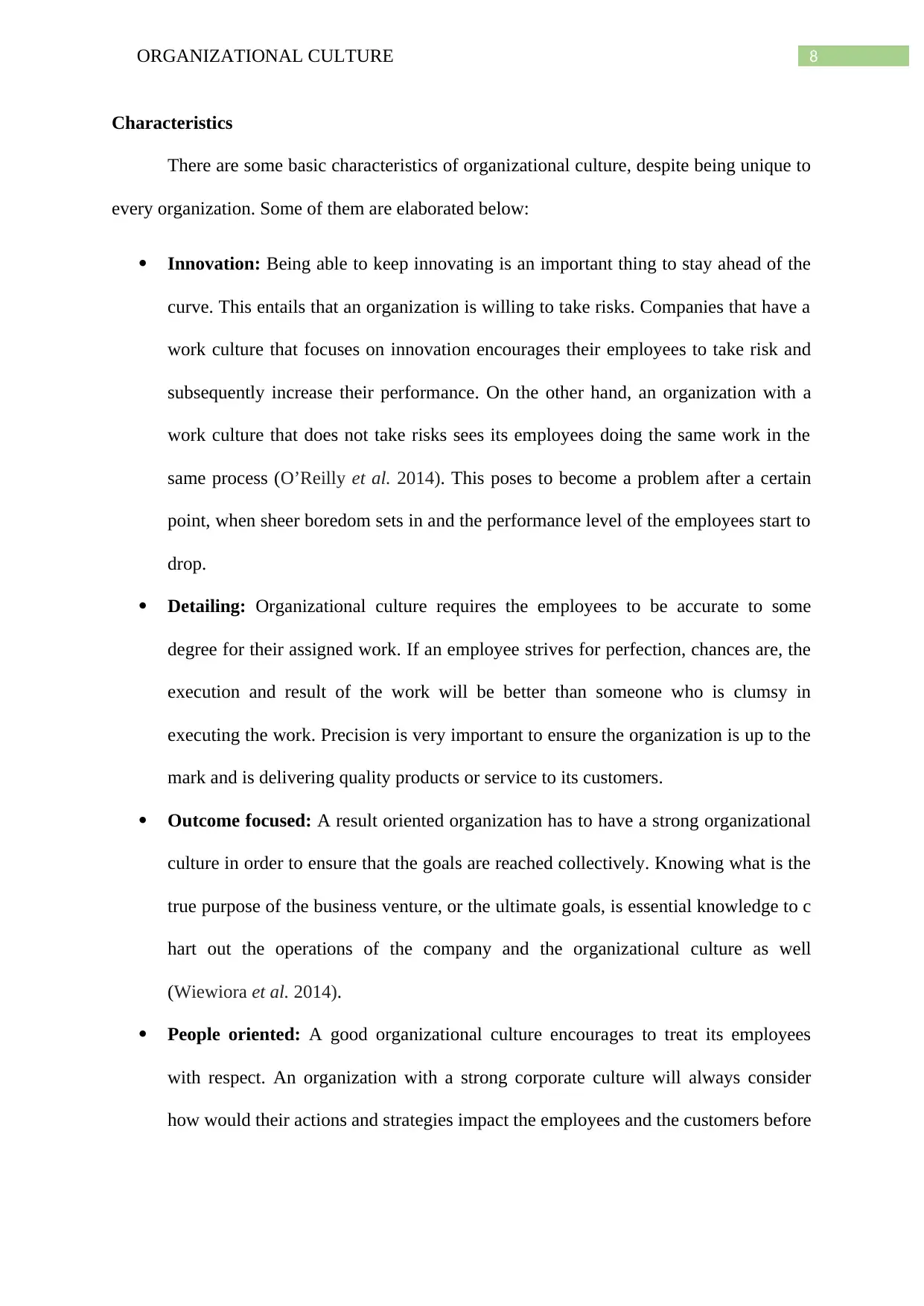
8ORGANIZATIONAL CULTURE
Characteristics
There are some basic characteristics of organizational culture, despite being unique to
every organization. Some of them are elaborated below:
Innovation: Being able to keep innovating is an important thing to stay ahead of the
curve. This entails that an organization is willing to take risks. Companies that have a
work culture that focuses on innovation encourages their employees to take risk and
subsequently increase their performance. On the other hand, an organization with a
work culture that does not take risks sees its employees doing the same work in the
same process (O’Reilly et al. 2014). This poses to become a problem after a certain
point, when sheer boredom sets in and the performance level of the employees start to
drop.
Detailing: Organizational culture requires the employees to be accurate to some
degree for their assigned work. If an employee strives for perfection, chances are, the
execution and result of the work will be better than someone who is clumsy in
executing the work. Precision is very important to ensure the organization is up to the
mark and is delivering quality products or service to its customers.
Outcome focused: A result oriented organization has to have a strong organizational
culture in order to ensure that the goals are reached collectively. Knowing what is the
true purpose of the business venture, or the ultimate goals, is essential knowledge to c
hart out the operations of the company and the organizational culture as well
(Wiewiora et al. 2014).
People oriented: A good organizational culture encourages to treat its employees
with respect. An organization with a strong corporate culture will always consider
how would their actions and strategies impact the employees and the customers before
Characteristics
There are some basic characteristics of organizational culture, despite being unique to
every organization. Some of them are elaborated below:
Innovation: Being able to keep innovating is an important thing to stay ahead of the
curve. This entails that an organization is willing to take risks. Companies that have a
work culture that focuses on innovation encourages their employees to take risk and
subsequently increase their performance. On the other hand, an organization with a
work culture that does not take risks sees its employees doing the same work in the
same process (O’Reilly et al. 2014). This poses to become a problem after a certain
point, when sheer boredom sets in and the performance level of the employees start to
drop.
Detailing: Organizational culture requires the employees to be accurate to some
degree for their assigned work. If an employee strives for perfection, chances are, the
execution and result of the work will be better than someone who is clumsy in
executing the work. Precision is very important to ensure the organization is up to the
mark and is delivering quality products or service to its customers.
Outcome focused: A result oriented organization has to have a strong organizational
culture in order to ensure that the goals are reached collectively. Knowing what is the
true purpose of the business venture, or the ultimate goals, is essential knowledge to c
hart out the operations of the company and the organizational culture as well
(Wiewiora et al. 2014).
People oriented: A good organizational culture encourages to treat its employees
with respect. An organization with a strong corporate culture will always consider
how would their actions and strategies impact the employees and the customers before
⊘ This is a preview!⊘
Do you want full access?
Subscribe today to unlock all pages.

Trusted by 1+ million students worldwide
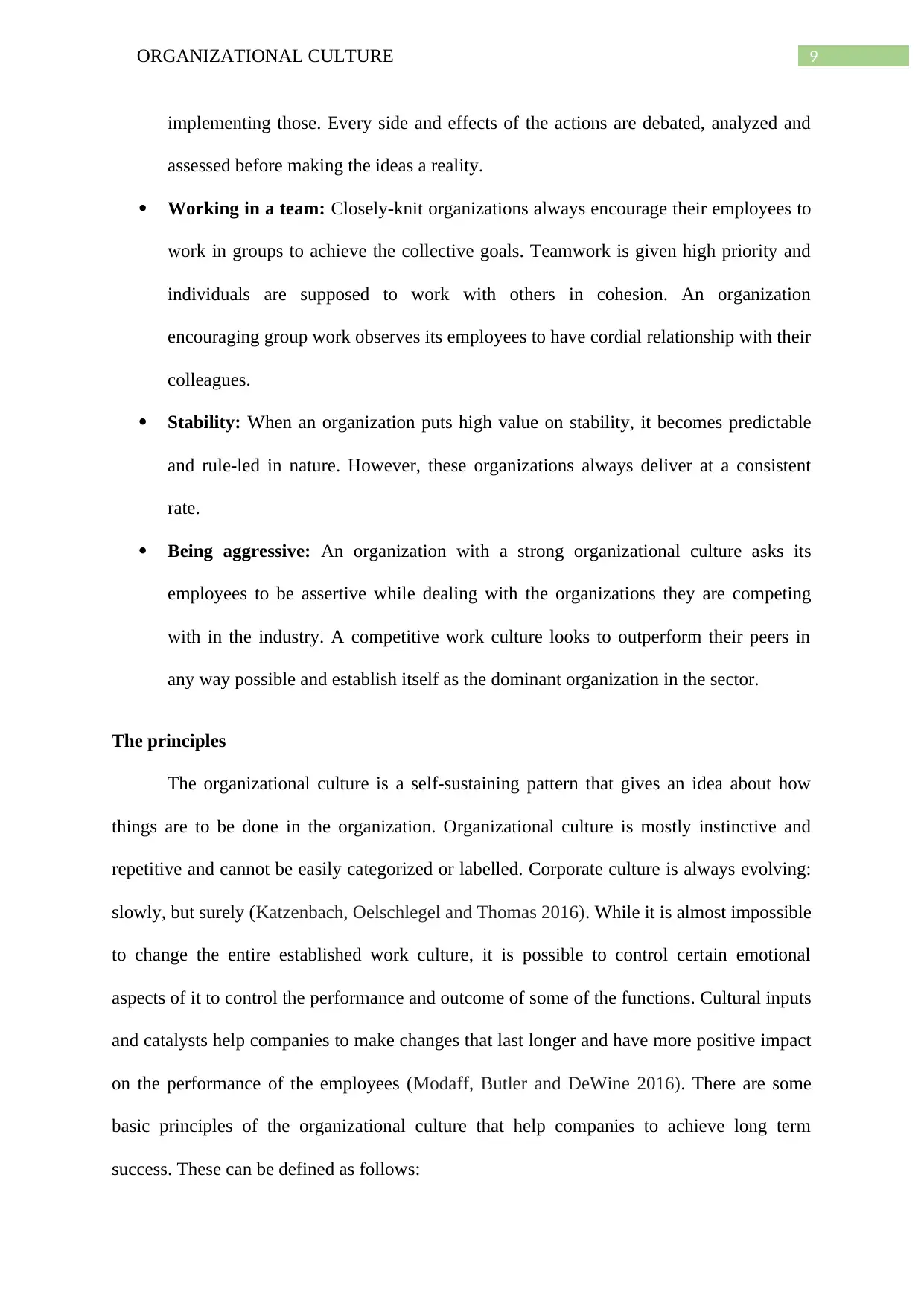
9ORGANIZATIONAL CULTURE
implementing those. Every side and effects of the actions are debated, analyzed and
assessed before making the ideas a reality.
Working in a team: Closely-knit organizations always encourage their employees to
work in groups to achieve the collective goals. Teamwork is given high priority and
individuals are supposed to work with others in cohesion. An organization
encouraging group work observes its employees to have cordial relationship with their
colleagues.
Stability: When an organization puts high value on stability, it becomes predictable
and rule-led in nature. However, these organizations always deliver at a consistent
rate.
Being aggressive: An organization with a strong organizational culture asks its
employees to be assertive while dealing with the organizations they are competing
with in the industry. A competitive work culture looks to outperform their peers in
any way possible and establish itself as the dominant organization in the sector.
The principles
The organizational culture is a self-sustaining pattern that gives an idea about how
things are to be done in the organization. Organizational culture is mostly instinctive and
repetitive and cannot be easily categorized or labelled. Corporate culture is always evolving:
slowly, but surely (Katzenbach, Oelschlegel and Thomas 2016). While it is almost impossible
to change the entire established work culture, it is possible to control certain emotional
aspects of it to control the performance and outcome of some of the functions. Cultural inputs
and catalysts help companies to make changes that last longer and have more positive impact
on the performance of the employees (Modaff, Butler and DeWine 2016). There are some
basic principles of the organizational culture that help companies to achieve long term
success. These can be defined as follows:
implementing those. Every side and effects of the actions are debated, analyzed and
assessed before making the ideas a reality.
Working in a team: Closely-knit organizations always encourage their employees to
work in groups to achieve the collective goals. Teamwork is given high priority and
individuals are supposed to work with others in cohesion. An organization
encouraging group work observes its employees to have cordial relationship with their
colleagues.
Stability: When an organization puts high value on stability, it becomes predictable
and rule-led in nature. However, these organizations always deliver at a consistent
rate.
Being aggressive: An organization with a strong organizational culture asks its
employees to be assertive while dealing with the organizations they are competing
with in the industry. A competitive work culture looks to outperform their peers in
any way possible and establish itself as the dominant organization in the sector.
The principles
The organizational culture is a self-sustaining pattern that gives an idea about how
things are to be done in the organization. Organizational culture is mostly instinctive and
repetitive and cannot be easily categorized or labelled. Corporate culture is always evolving:
slowly, but surely (Katzenbach, Oelschlegel and Thomas 2016). While it is almost impossible
to change the entire established work culture, it is possible to control certain emotional
aspects of it to control the performance and outcome of some of the functions. Cultural inputs
and catalysts help companies to make changes that last longer and have more positive impact
on the performance of the employees (Modaff, Butler and DeWine 2016). There are some
basic principles of the organizational culture that help companies to achieve long term
success. These can be defined as follows:
Paraphrase This Document
Need a fresh take? Get an instant paraphrase of this document with our AI Paraphraser
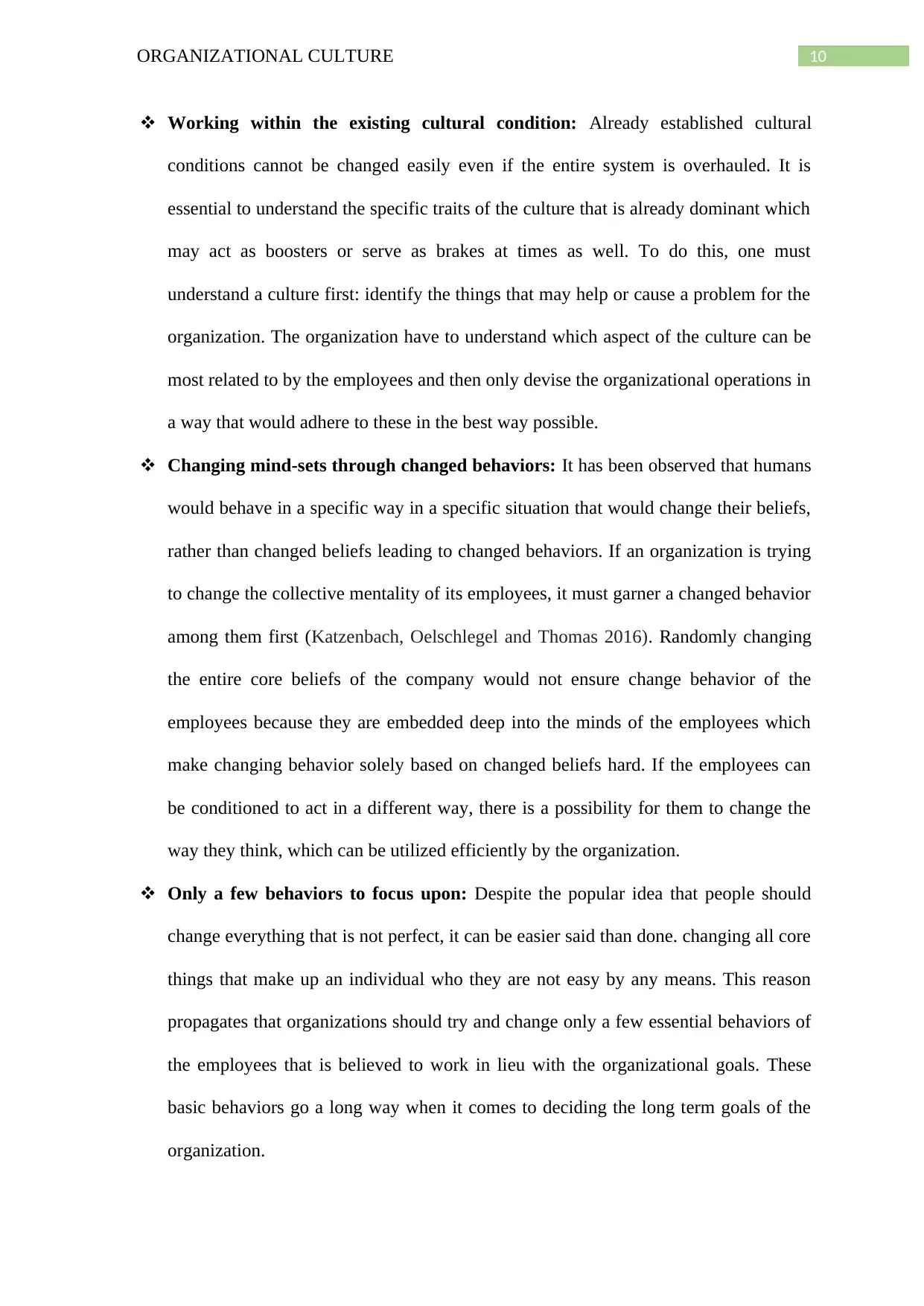
10ORGANIZATIONAL CULTURE
Working within the existing cultural condition: Already established cultural
conditions cannot be changed easily even if the entire system is overhauled. It is
essential to understand the specific traits of the culture that is already dominant which
may act as boosters or serve as brakes at times as well. To do this, one must
understand a culture first: identify the things that may help or cause a problem for the
organization. The organization have to understand which aspect of the culture can be
most related to by the employees and then only devise the organizational operations in
a way that would adhere to these in the best way possible.
Changing mind-sets through changed behaviors: It has been observed that humans
would behave in a specific way in a specific situation that would change their beliefs,
rather than changed beliefs leading to changed behaviors. If an organization is trying
to change the collective mentality of its employees, it must garner a changed behavior
among them first (Katzenbach, Oelschlegel and Thomas 2016). Randomly changing
the entire core beliefs of the company would not ensure change behavior of the
employees because they are embedded deep into the minds of the employees which
make changing behavior solely based on changed beliefs hard. If the employees can
be conditioned to act in a different way, there is a possibility for them to change the
way they think, which can be utilized efficiently by the organization.
Only a few behaviors to focus upon: Despite the popular idea that people should
change everything that is not perfect, it can be easier said than done. changing all core
things that make up an individual who they are not easy by any means. This reason
propagates that organizations should try and change only a few essential behaviors of
the employees that is believed to work in lieu with the organizational goals. These
basic behaviors go a long way when it comes to deciding the long term goals of the
organization.
Working within the existing cultural condition: Already established cultural
conditions cannot be changed easily even if the entire system is overhauled. It is
essential to understand the specific traits of the culture that is already dominant which
may act as boosters or serve as brakes at times as well. To do this, one must
understand a culture first: identify the things that may help or cause a problem for the
organization. The organization have to understand which aspect of the culture can be
most related to by the employees and then only devise the organizational operations in
a way that would adhere to these in the best way possible.
Changing mind-sets through changed behaviors: It has been observed that humans
would behave in a specific way in a specific situation that would change their beliefs,
rather than changed beliefs leading to changed behaviors. If an organization is trying
to change the collective mentality of its employees, it must garner a changed behavior
among them first (Katzenbach, Oelschlegel and Thomas 2016). Randomly changing
the entire core beliefs of the company would not ensure change behavior of the
employees because they are embedded deep into the minds of the employees which
make changing behavior solely based on changed beliefs hard. If the employees can
be conditioned to act in a different way, there is a possibility for them to change the
way they think, which can be utilized efficiently by the organization.
Only a few behaviors to focus upon: Despite the popular idea that people should
change everything that is not perfect, it can be easier said than done. changing all core
things that make up an individual who they are not easy by any means. This reason
propagates that organizations should try and change only a few essential behaviors of
the employees that is believed to work in lieu with the organizational goals. These
basic behaviors go a long way when it comes to deciding the long term goals of the
organization.
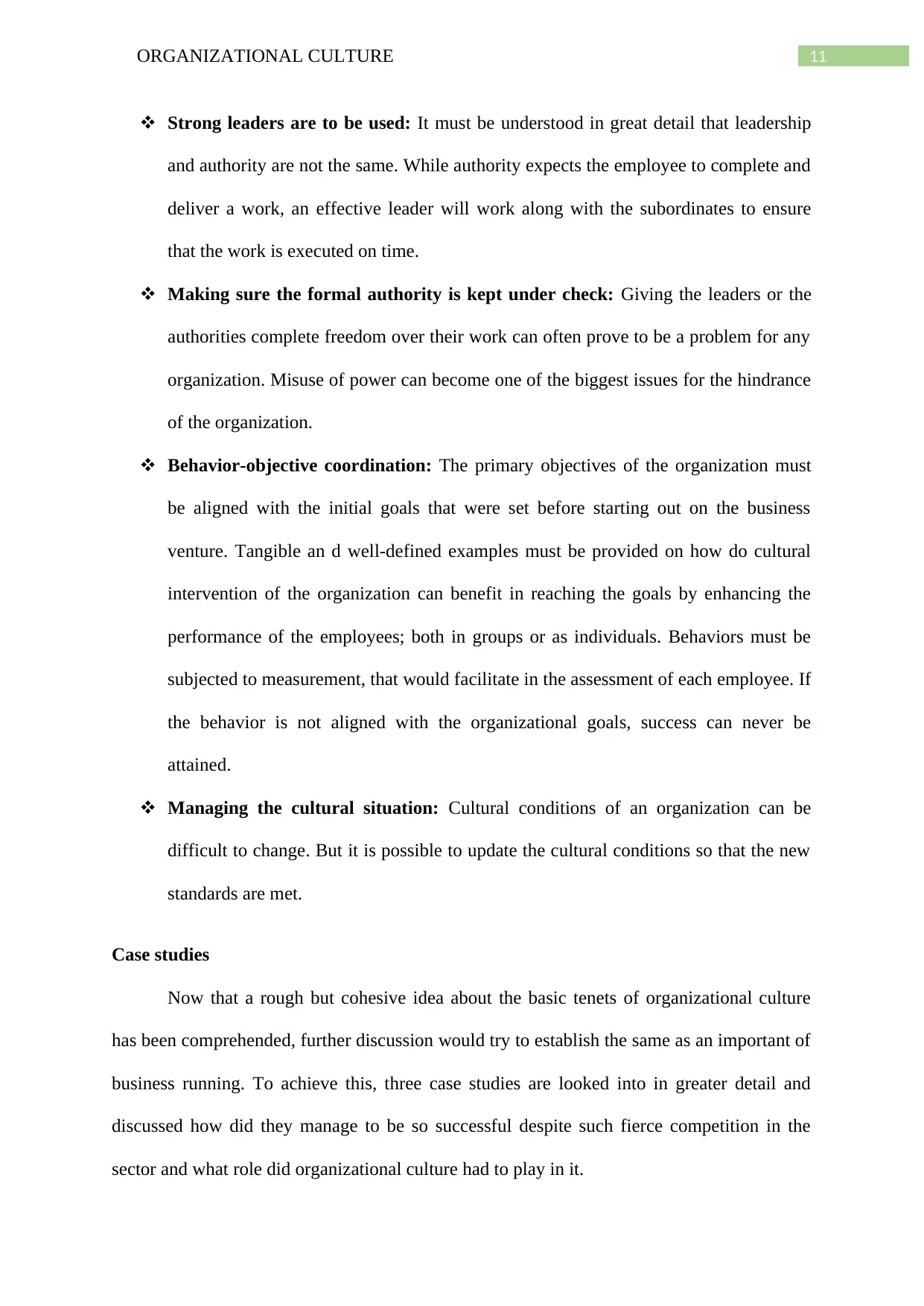
11ORGANIZATIONAL CULTURE
Strong leaders are to be used: It must be understood in great detail that leadership
and authority are not the same. While authority expects the employee to complete and
deliver a work, an effective leader will work along with the subordinates to ensure
that the work is executed on time.
Making sure the formal authority is kept under check: Giving the leaders or the
authorities complete freedom over their work can often prove to be a problem for any
organization. Misuse of power can become one of the biggest issues for the hindrance
of the organization.
Behavior-objective coordination: The primary objectives of the organization must
be aligned with the initial goals that were set before starting out on the business
venture. Tangible an d well-defined examples must be provided on how do cultural
intervention of the organization can benefit in reaching the goals by enhancing the
performance of the employees; both in groups or as individuals. Behaviors must be
subjected to measurement, that would facilitate in the assessment of each employee. If
the behavior is not aligned with the organizational goals, success can never be
attained.
Managing the cultural situation: Cultural conditions of an organization can be
difficult to change. But it is possible to update the cultural conditions so that the new
standards are met.
Case studies
Now that a rough but cohesive idea about the basic tenets of organizational culture
has been comprehended, further discussion would try to establish the same as an important of
business running. To achieve this, three case studies are looked into in greater detail and
discussed how did they manage to be so successful despite such fierce competition in the
sector and what role did organizational culture had to play in it.
Strong leaders are to be used: It must be understood in great detail that leadership
and authority are not the same. While authority expects the employee to complete and
deliver a work, an effective leader will work along with the subordinates to ensure
that the work is executed on time.
Making sure the formal authority is kept under check: Giving the leaders or the
authorities complete freedom over their work can often prove to be a problem for any
organization. Misuse of power can become one of the biggest issues for the hindrance
of the organization.
Behavior-objective coordination: The primary objectives of the organization must
be aligned with the initial goals that were set before starting out on the business
venture. Tangible an d well-defined examples must be provided on how do cultural
intervention of the organization can benefit in reaching the goals by enhancing the
performance of the employees; both in groups or as individuals. Behaviors must be
subjected to measurement, that would facilitate in the assessment of each employee. If
the behavior is not aligned with the organizational goals, success can never be
attained.
Managing the cultural situation: Cultural conditions of an organization can be
difficult to change. But it is possible to update the cultural conditions so that the new
standards are met.
Case studies
Now that a rough but cohesive idea about the basic tenets of organizational culture
has been comprehended, further discussion would try to establish the same as an important of
business running. To achieve this, three case studies are looked into in greater detail and
discussed how did they manage to be so successful despite such fierce competition in the
sector and what role did organizational culture had to play in it.
⊘ This is a preview!⊘
Do you want full access?
Subscribe today to unlock all pages.

Trusted by 1+ million students worldwide
1 out of 24
Related Documents
Your All-in-One AI-Powered Toolkit for Academic Success.
+13062052269
info@desklib.com
Available 24*7 on WhatsApp / Email
![[object Object]](/_next/static/media/star-bottom.7253800d.svg)
Unlock your academic potential
Copyright © 2020–2025 A2Z Services. All Rights Reserved. Developed and managed by ZUCOL.





